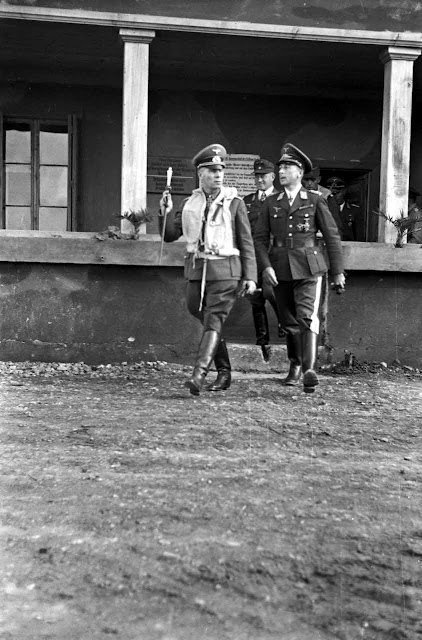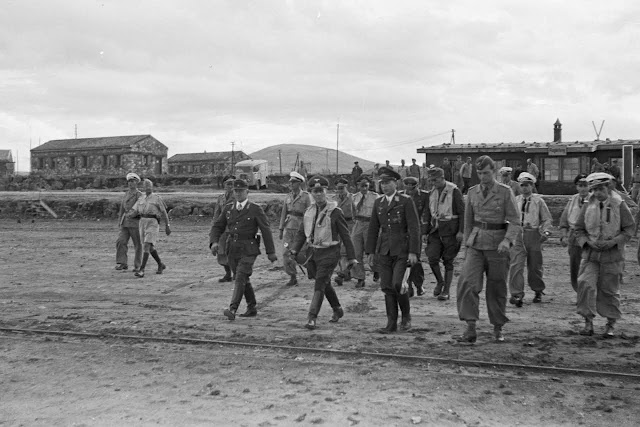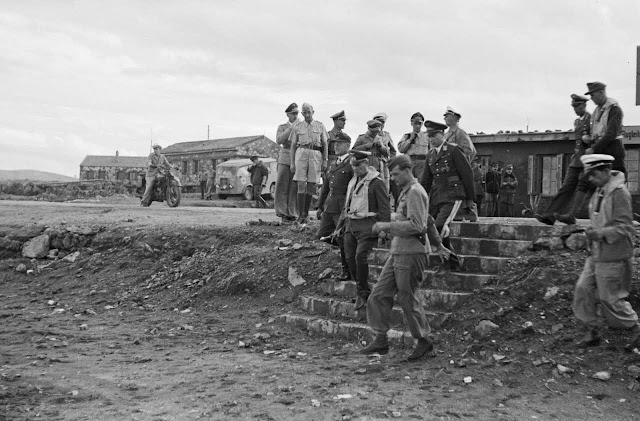
Generalmajor
Erwin Rommel is wearing the Offiziermantel (officer coat) in this
photo, taken in early 1940. He is still wearing the Pour le Mérite that
he received in World War One, while there is still no additional
Ritterkreuz medal around his neck. Rommel himself was awarded the Pour
le Mérite, the German Empire's highest medal of courage, in the First
World War - on December 10, 1917 - after the Battle of Caporetto which
he captured 7,000 Italian soldiers with only 100 men! Rommel's first
combat command in World War II was as Commander of the 7th
Panzer-Division. which he led in the fighting in France in 1940. During
the campaign, 7. The Panzer-Division suffered more casualties than any
other division throughout the Wehrmacht: it lost 2,594 men (including
682 killed, 1,646 wounded, and 266 missing) - which accounts for 20
percent of its total force - plus 39 tanks destroyed. But all of these
sacrifices were paid for with great achievements: from May to June 1940,
7. Panzer-Division captured 97,486 Allied soldiers, c458 tanks and
other armored vehicles, seized 277 field guns, 64 anti-tank guns.,
4,000-5,000 trucks, as well as destroying dozens of other vehicles. Not
only that, this division was also able to seize or destroy hundreds of
tons of other very valuable military equipment, as well as shoot down 52
warplanes (plus destroying 15 aircraft on the ground and confiscate 12
others intact). 7. Panzer-Division also managed to capture the Commander
of the French Atlantic Fleet and four admirals, a French Army Corps
Commander, 15-20 other French generals, and one British general. In the
process, the division emerged surprisingly from the dense Ardennes
Forest, broke through the defenses on the banks of the Meuse River in
Dinart, and advanced through Belgium and northern France. All forces
that came in his way were mercilessly crushed (including the French 1st
Armored Division and the 4th North African Division), and their swift
movement allowed them to penetrate the extension of the Maginot Line
near Sivry, and withstand the largest Allied counterattack in the Battle
of France, deployed in the open field of Arras. Subsequently, 7.
Panzer-Division played an important role in the siege and destruction of
the mighty French 1st Army at Lille, which was followed by a rapid
advance southward, storming through the Somme and Seine, and ended with
the capture - after a fierce battle - of the main French port of St.
Valery and Cherbourg... and all of this amazing achievement was done
almost without the help of the rest of the German units! The 7.
Panzer-Division was nicknamed the "Gespenster Division" (Ghost Division)
by the Wehrmacht high ranking officers in Berlin, who were often
confused by the fact that how often this division were "lost" without
news for days, only to reappear with a shocking victory far away through
enemy territory! By the time the French finally surrendered, the
division was about 320 kilometers from the border with Spain. It could
be said that in the period from February 5, 1940 to February 15, 1941,
Erwin Rommel had performed very well for his duties as a
Divisionskommandeur!

Generalmajor
Erwin Rommel was appointed as a Commander of the 7. The
Panzer-Division, replacing Generalleutnant Georg Stumme, in February
1940. At first he made a less-than-promising impression when - on the
first day of his arrival - saluted his senior commanders with a Nazi
salute instead of a usual military salute! (though Rommel was eventually
forced to commit suicide in 1944 for alleged involvement in the
anti-Hitler movement, but in 1939 he was Head of Hitler's Bodyguard
Battalion and, as such, had become a Nazi fanatic in 1940). The "newbie"
Division Commander also offended his officers when he said that most of
the 7th Panzer-Division were comes from Thuringia, a region that is
considered rarely producing quality soldiers! Not enough, Rommel
immediately ordered a general inspection of the entire army the next day
– which happened to be a Sunday – which was an unusual thing to do and,
therefore, very unpopular with the soldiers. All of this, coupled with
the fact that Rommel was seen as a mere “Hitler's consignment” and had
no experience in an armored unit at all, made most of the 7th
Panzer-Division officers hate him. Rommel realized this too, and he
overcame it in one drastic measure: on February 29, 1940 Rommel suddenly
fired a battalion commander who was considered a nuisance, and made him
leave the division headquarters in just an hour and a half! This
ruthless act of tolerance shocked the entire division, and forced them
to obey Rommel's further instructions - at first reluctantly, but then
done with a full support when they saw that the Divisionskommandeur
always at the forefront of every battle, slept in the tent with the
grass as a floor, and ate the same rations eaten by the lowest-ranking
soldiers in his unit!

Generalmajor
Erwin Rommel (seated at left, Kommandeur 7. Panzer-Division) studying
maps with his officers. This photo was taken during the German invasion
of France, May 1940

Generalmajor
Erwin Rommel (Kommandeur 7. Panzer-Division) with map and binoculars on
foot on the way to the Scarpe section, while Panzer 35(t)s is waiting
on the left. The picture was taken around the end of May or beginning of
June 1940 at Nord-Pas-de-Calais, France.

Divisionskommandeur
Rommel is having a casual discussion with his officers from the
Panzer-Regiment 25 / 7.Panzer-Division near the banks of the river Seine
(France), mid-June 1940. From left to right: Major Franz von Lindenau
(Kommandeur I.Abteilung /
Panzer -Regiment 25), Oberst Karl Rothenburg (Kommandeur Panzer-Regiment
25), Major Casimir Kentel (Kommandeur II.Abteilung / Panzer-Regiment
25), Hauptmann Adelbert Schulz (Chef 1.Kompanie / I.Abteilung /
Panzer-Regiment 25), Generalmajor Erwin Rommel (Kommandeur 7.
Panzer-Division), and Major iG Otto Heidkämper (Ia Erster
Generalstabsoffizier 7. Panzer-Division). In the Battle of France, 7.
Panzer-Division was equipped with outdated Czechoslovakian tanks (some
of them are visible in the background). The division, resuming its
advance on 5 June, drove for the River Seine to secure the bridges near
Rouen. Advancing 100 kilometres (62 mi) in two days, the division
reached Rouen to find the bridges destroyed. From here they moved north,
blocking the westward route to Le Havre and the Operation Cycle
evacuations and forcing over 10,000 men of the 51st (Highland) Division,
French 9th Army Corps and other supporting troops to surrender at
Saint-Valery-en-Caux on 12 June.

Generalmajor
Erwin Rommel (Kommandeur 7. Panzer-Division) at the "Hoth Tag" event
held in front of the Place des Quinconces, Bordeaux, France, 29 June
1940 (other versions mention 1 July 1940 as the date). To the right is
his aide, Hauptmann Hans-Joachim Schraepler. On 24 June 1940, 7.
Panzer-Division arrived in Bordeaux. Five days later, the division held a
victory parade in the streets of the city in northern France under the
direct leadership of the Divisionskommandeur Rommel. Until the spring of
1941, 7. Panzer-Division spent a period of rest and refitting at the
"Camp de Sougè", located in Martignas-sur-Jalle. All of this information
comes from a letter sent by Rommel to his beloved wife, Lucie, dated 6
January 1941. The position of his own division was as a reserve force of
the Wehrmacht, prepared for Unternehmen Seelöwe (Operation Sea Lion,
the planned German invasion of England). The invasion was later called
off after the Luftwaffe was battered in the Battle of Britain. BTW, I
believe this is the only picture showing Rommel wearing stahlhelm (steel
helmet)!

Award ceremony in Reichskanzlei, Berlin, 25 March 1941: Adolf Hitler
(Führer und Reichskanzler) decorates Generalleutnant Erwin Rommel
(Kommandeur 7. Panzer-Division) with Ritterkreuz des Eisernen Kreuzes
mit Eichenlaub #10 (Knight's Cross with the Iron Crosses Nr.10). The man
in the picture is Hitler's clossest ally, Benito Mussolini.
---------------------------------------------------------------------------------------------
UNCAPTIONEDThese pictures is one of 854 photographs from the Rommel Photograph
Collection located in the US National Archives and Records
Administration (NARA). The photographs depict military activities in
the French campaign in 1940 and were taken by various German photographers and
copies provided to General Rommel as a courtesy. There are photos of
equipment and troops in action, landscape scenes, as well as photos of
Rommel and a few other German leaders. The collection contains scanned
jpeg images of every photograph of the French campaign in the NARA
collection (except for the duplicates). Includes images of 12 Heinrich
Hoffman photographs of Rommel’s visit with Hitler. Each photo was
scanned at 600 dpi and if captioned, the reverse was scanned at 150
dpi. Since most photographs in the collection are not captioned, the
scans are not cataloged, although they are organized by photograph type
and, when possible, grouped by subject. Some of the photographs are
dated and captioned in German.
Source :
Bundesarchiv picture collection
"Rommel's Lieutenants: The Men Who Served the Desert Fox" by Samuel W. Mitcham
http://alifrafikkhan.blogspot.com/2012/03/album-foto-erwin-rommel-sebagai_10.html
 At
the airfield of Heraklion, Generalfeldmarschall Erwin Rommel inspects
the guard of honor while with the back to the camera is Generalmajor
Friedrich-Wilhelm Müller and Generalleutnant Otto Hoffmann von Waldau.
At
the airfield of Heraklion, Generalfeldmarschall Erwin Rommel inspects
the guard of honor while with the back to the camera is Generalmajor
Friedrich-Wilhelm Müller and Generalleutnant Otto Hoffmann von Waldau. At
the airfield of Heraklion, Generalfeldmarschall Erwin Rommel is greeted
by Generalleutnant Otto Hoffmann von Waldau. Between them is
Generalmajor Alfred Gause, Rommel's Chief of Staff.
At
the airfield of Heraklion, Generalfeldmarschall Erwin Rommel is greeted
by Generalleutnant Otto Hoffmann von Waldau. Between them is
Generalmajor Alfred Gause, Rommel's Chief of Staff. Generalfeldmarschall
Erwin Rommel is walking with his entourages after landing in Heraklion
airfield, Crete. From left to right: Rommel, Generalmajor
Friedrich-Wilhelm Müller, unknown Luftwaffe officer, Generalleutnant
Otto Hoffmann von Waldau, and Generalmajor Alfred Gause.
Generalfeldmarschall
Erwin Rommel is walking with his entourages after landing in Heraklion
airfield, Crete. From left to right: Rommel, Generalmajor
Friedrich-Wilhelm Müller, unknown Luftwaffe officer, Generalleutnant
Otto Hoffmann von Waldau, and Generalmajor Alfred Gause.

 From
left to right: Generalmajor Friedrich-Wilhelm Müller (Kommmandeur 22.
Infanterie-Division), Generalfeldmarschall Erwin Rommel
(Oberbefehlshaber Panzerarmee "Africa"), and Generalleutnant Otto
Hoffmann von Waldau (Fliegerführer "Africa").
From
left to right: Generalmajor Friedrich-Wilhelm Müller (Kommmandeur 22.
Infanterie-Division), Generalfeldmarschall Erwin Rommel
(Oberbefehlshaber Panzerarmee "Africa"), and Generalleutnant Otto
Hoffmann von Waldau (Fliegerführer "Africa").

 At the airfield of Heraklion (Crete), Generalfeldmarschall Erwin Rommel
step down the stairs, followed by Generalmajor Friedrich-Wilhelm Müller and Generalleutnant Otto Hoffmann von Waldau.
At the airfield of Heraklion (Crete), Generalfeldmarschall Erwin Rommel
step down the stairs, followed by Generalmajor Friedrich-Wilhelm Müller and Generalleutnant Otto Hoffmann von Waldau. As
Generalfeldmarschall Erwin Rommel takes his place in the Dornier
Do-215, Generalleutnant Otto Hoffmann von Waldau chats with an
unidentified Luftwaffe officer. Blocked by von Waldau is Generalmajor
Friedrich-Wilhelm Müller.
As
Generalfeldmarschall Erwin Rommel takes his place in the Dornier
Do-215, Generalleutnant Otto Hoffmann von Waldau chats with an
unidentified Luftwaffe officer. Blocked by von Waldau is Generalmajor
Friedrich-Wilhelm Müller. On board a Dornier Do-215, Generalfeldmarschall Erwin Rommel leaves the field of Heraklion for El Alamein, Egypt.
On board a Dornier Do-215, Generalfeldmarschall Erwin Rommel leaves the field of Heraklion for El Alamein, Egypt.
 Generalleutnant Otto Hoffmann von Waldau, Generalmajor
Friedrich-Wilhelm Müller and Luftwaffe airmen watches together while
Generalfeldmarschall Erwin Rommel's plane leave the Heraklion airfield
(Crete) and flew to El Alamein, Egypt.
Generalleutnant Otto Hoffmann von Waldau, Generalmajor
Friedrich-Wilhelm Müller and Luftwaffe airmen watches together while
Generalfeldmarschall Erwin Rommel's plane leave the Heraklion airfield
(Crete) and flew to El Alamein, Egypt.


































